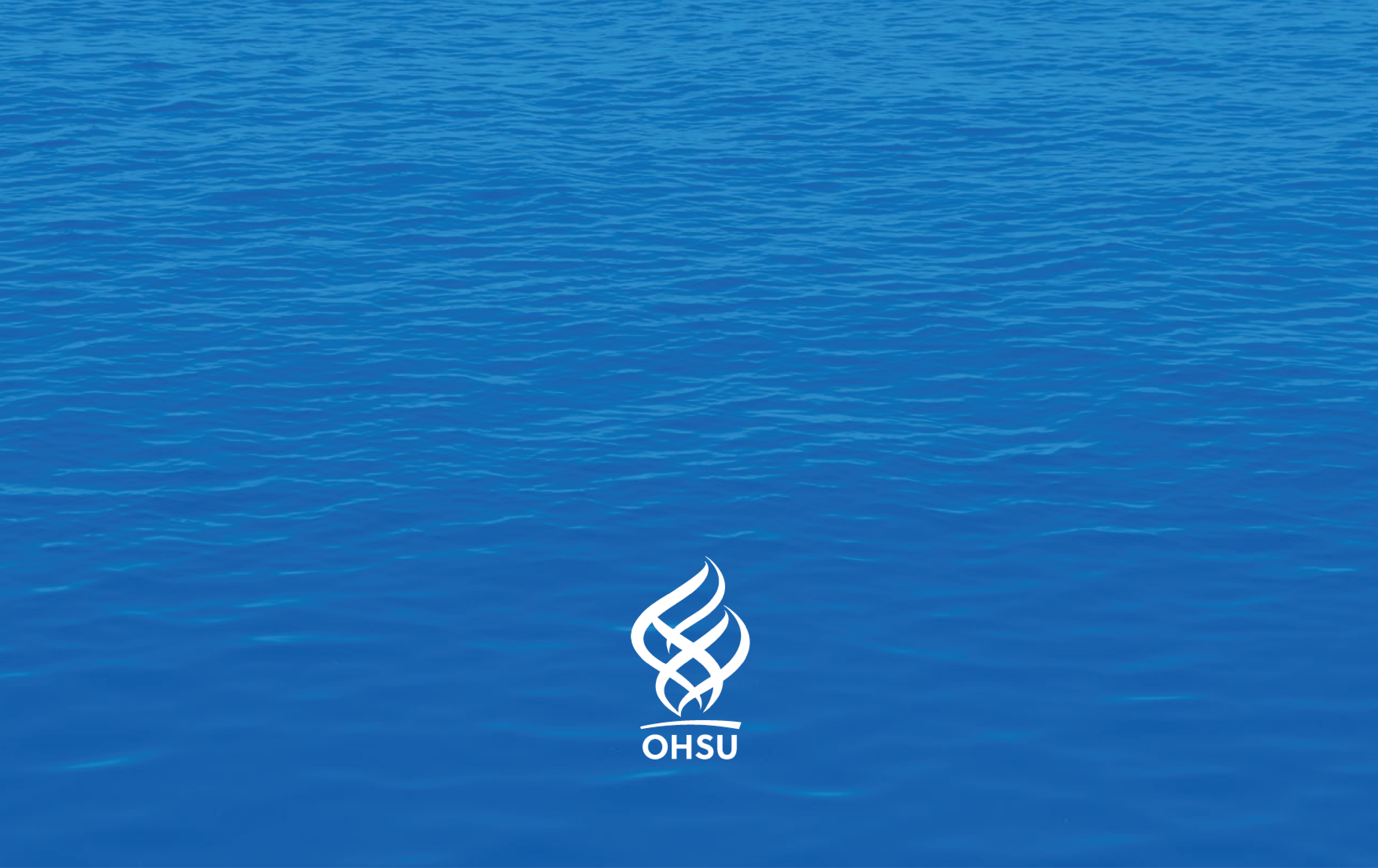Recruitment Manual 2022

Acknowledgements
This edition of the OHSU Recruitment Manual would not exist without the ideas, insights, time and devotion of dozens of dedicated faculty and staff from across the institution. We thank everyone who contributed to creating a more diverse and inclusive community and for bringing this critical resource to life. This Recruitment manual would not be possible without the efforts of several members—Linzy Rodrigues, Tony Mareino, Lisa Huynh, Jennifer Gossett, Ian Jaquiss, Octaviano Merecias-Cuevas and Holly Yoo. Thank you to Leslie Garcia for her advice and continued partnership with this project. We also thank everyone in the OHSU community who have used the recommendations in the previous versions of this manual to shift the way you recruit, screen, interview, hire, and retain the members of your team. Because of you, we are making progress toward the vision of an inclusive campus and a stronger, healthier and more innovative future for our organization and the communities we serve.
Throughout the manual, you will see several references of the Search Advocate manual and the Higher Education Recruitment Consortium (HERC) search committee tools, as well as existing OHSU HR Policies and documentation.
Together, we are creating a more diverse and inclusive OHSU. Thank you for your work and your continued commitment to this journey.
Introduction
This recruitment manual will focus on the recruitment and selection process for faculty, staff, and trainee positions with the aim of conducting effective searches that will assist in diversifying the applicant pool and attracting the best candidates to OHSU. The procedures discussed within this manual apply to all available staff and faculty positions to assist in their recruitment and selection. To learn if your position(s) have placement goals, contact the OHSU Office of Civil Rights Investigations and Compliance as the first step in recruitment efforts. The OCIC can be reached at 503-494-5148 or ocic@ohsu.edu.
As part of OHSU’s commitment to diversity and affirmative action federal requirements, OHSU annually reviews personnel hiring, promotions and terminations. Based on this analysis, placement goals for women and minorities, utilization goals for individuals with disabilities, and hiring benchmarks for protected veterans are set and serve as a guide for recruitment efforts in these areas. Throughout the affirmative action plan year, progress towards these goals and benchmarks, and good faith outreach efforts are monitored. For the purposes of this guide, we will focus on areas of diversity, equity and inclusion within our recruitment and highlight a few more resources available.
Letter from the President
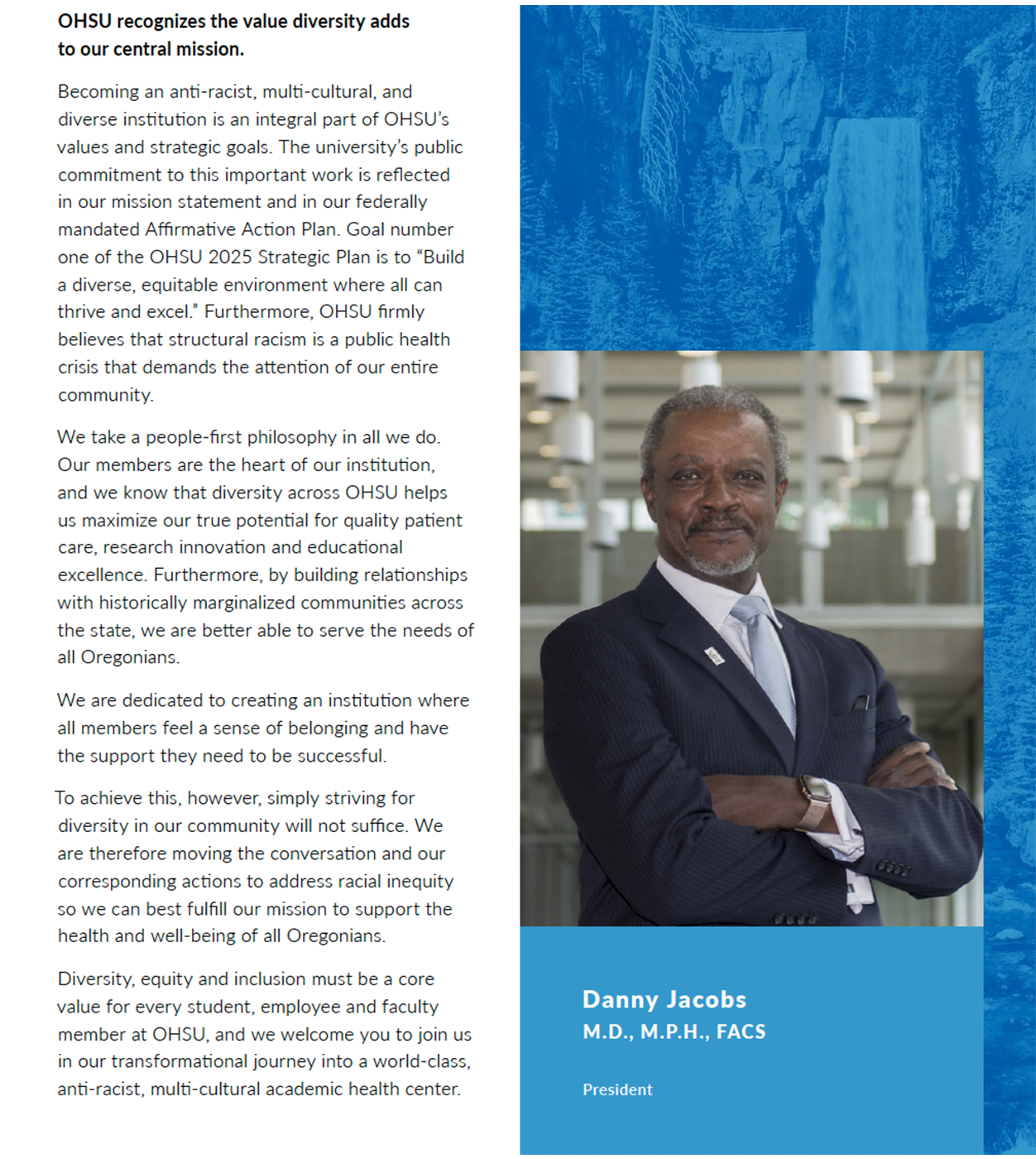
Letter from Senior Vice President, Diversity, Equity and Inclusion
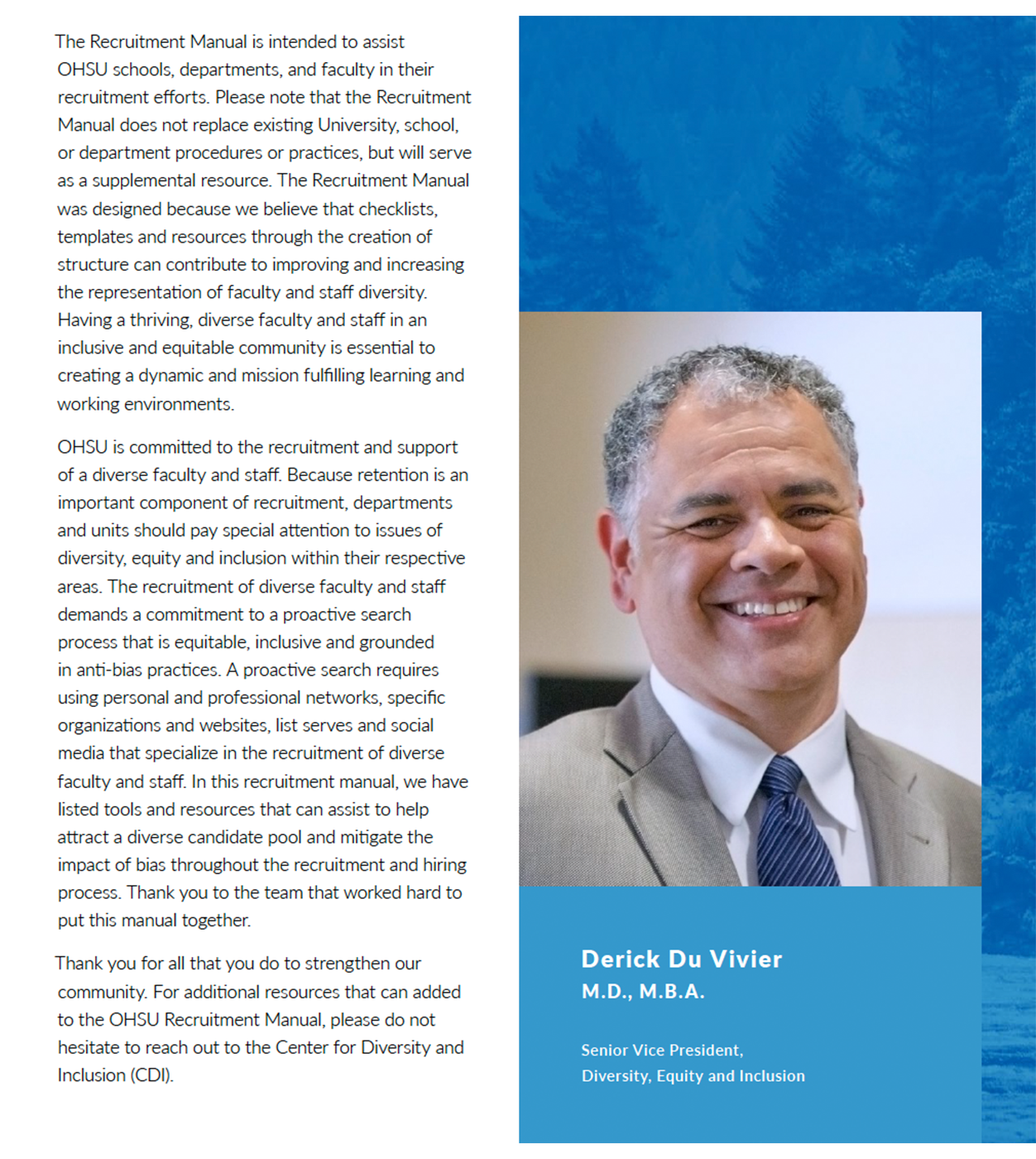
Recruitment process overview
Starting July 1, 2021, hiring managers need to complete the Unconscious Bias for Hiring Managers in order to post a position for recruitment. To post your position, please follow the steps on the recruitment O2 page. Please be mindful, and utilize the OHSU Policy Manual and Code of Conduct. Below is a recruitment process flow chart with hyperlinks to the O2 page for the details on the steps:





Prepare for recruitment and posting tips
• Reach out to a search advocate who can help review the position description for inclusive language and be on the search committee.
• Review the OCIC placement goals on the next page of this manual
• The Office of Civil Rights Investigations and Compliance provides strategy tips to assist managers in addressing any underutilization of diverse individuals.
• Ensure the position description is up-to-date with job duties and essential functions
• Post your job in a consistent format shown here and emphasize the relevance of diversity, equity and inclusion to the work of the position.
• Use inclusive language in the position description. Inclusive language will help avoid biases, or expressions that discriminate against groups of people based on race, gender, or socioeconomic status. Here is the inclusive language guide to use for reference
• Review language for determination of compensation
• See Appendix C for a list of recruitment websites that you can use to post your position. Note: Make sure your position has been approved to be posted externally.
A search advocate is
• A vital consultant in the hiring process
• An incorporated partner with search committee members to determine position description development, recruitment and interviews for new employees, as well as evaluation.
Email jeditraining@ohsu.edu for more information.
Affirmative action policies
All hiring entities are required to learn about their department’s Affirmative Action placement goals before creating a position description.
Federal contractor job listing (FCJL) requirements
The affirmative action provisions of Vietnam Era Veterans Readjustment Assistance Act (VEVRAA) require covered contractors and subcontractors to take affirmative action to employ and advance in employment qualified covered veterans (38 U.S.C. 4212(a)). To implement the affirmative action requirement, VEVRAA and OFCCP’s (U.S. DOL Office of Federal Contract Compliance Programs) implementing regulations require contractors and subcontractors to list most employment openings with an appropriate employment service delivery system. Each such employment service delivery system is to provide protected veterans priority referrals to such openings. Positions that will be filled from within the contractor’s organization and positions lasting three days or less are exempt from this mandatory job-listing requirement. Listing employment openings with the State workforce agency job bank or with the local employment service delivery system where the opening occurs will satisfy the requirement to list jobs with the local employment service delivery system. Additional information can be found here.
The Vietnam Era Veterans Readjustment Assistance Act (VEVRAA) has the following new rules that are effective March 24, 2014:
• Self-identification: Invite all candidates to selfidentify as veterans at pre-offer (new) and post-offer(more specific categories). Invite employees to self-identify as veterans pre-offer in 2014–2015.
• Data collection: Document veteran candidates and hires. Keep records for three years.
• Hiring benchmarks: Requires establishment of annual hiring benchmarks of 8% for protected veterans.
• Reasonable accommodation: More proactive requirements to reach out to known disabled veterans.
• Outreach and recruitment: “Appropriate outreach and positive recruitment activities” for particular needs and circumstances.
• Self-assessment: Annual review of outreach and recruitment of vets, critical evaluation of effectiveness of efforts and modification of unsuccessful efforts.
Required equal opportunity clause in subcontracts. Required posting of job openings in state employment delivery systems. Required notices. Availability of Affirmative Action Placement (AAP) to any requesting employee or applicant. Notify unions of policy and request cooperation. Various pictures of disabled veterans in handbooks and publications. Periodic review of physical and mental job standards. AAP training for all involved in recruitment, screening, selection, promotion and discipline.
The following new rules are effective March 24, 2014:
• Self-identification: Invite all candidates to self-identify as IWDs at pre-offer and post-offer. Invite employees to self-identify as IWDs in 2014–2015,
every five years thereafter.
• Data collection: Document IWD candidates and hires. Keep records for three years.
• Goal required: Annual utilization goal for IWD in each job group is found here.
• Outreach and recruitment: “Appropriate outreach and positive recruitment activities” for particular needs and circumstances.
• Self-assessment: Annual review of outreach and recruitment of IWD, critical evaluation of effectiveness of efforts and modification of unsuccessful efforts.
• Miscellaneous:
» Required Equal Opportunity (EO) clause in subcontracts.
» Required posting of job openings in state employment delivery systems may give priority consideration of employment to IWD.
» Periodic review of physical and mental job standards.
» Affirmative Action Placement training for all involved in recruitment, screening, selection, promotion and discipline.
Placement goals
As part of its commitment to diversity, equity, inclusion and affirmative action, OHSU sets annual placement goals for women and minorities, utilization goals for individuals with disabilities, and hiring benchmarks for protected veterans.
The purpose of these goals is to serve as a guide to underrepresentation of these categories in our workforce. Recruitment efforts should specifically have outreach efforts to identified groups, ensuring a diverse pool of applicants.
Policy No. 03-05-025, Effective Date: April 27, 2017
- OHSU shall establish an affirmative action plan including outreach, placement goals and procedures for the purpose of increasing the proportion and effective utilization of minorities, women, individuals with disabilities, and protected Veterans.
- For purposes of affirmative action policy, “minorities” refers to Black or African Americans, Hispanic or Latino Americans, Asians, Native Hawaiian or Other Pacific-Islanders, and American Indians or Alaskan Natives, and persons of two or more races.
- The President will review the affirmative action plan annually to assess the adequacy and effectiveness of the plan.
Job description
Job posting language
It is encouraged to create a long and short version of the job posting; for use in different venues.
• Brief Summary: Description of the role intended to engage and interest job searchers.
• Longform: Full job description that includes information on the role, the department, and the requirements for the position.
Candidates may be reading on mobile or tablet devices, so be mindful of the posting’s length and verbosity.
Inclusive language
Inclusive language should be included as a specific job qualification or as a summary statement in the job announcement. Examples include:
• Women, minorities, individuals with disabilities and veterans are encouraged to apply.
• Do not use BIPOC, People of color and other descriptors from social media. OHSU has standard descriptors. See OHSU Fact Book for assistance.
• The University is committed to building a culturally diverse educational environment.
For faculty job announcements:
• The University is responsive to the needs of dualcareer couples. OHSU is a member of the Higher Education Recruitment Consortium (HERC). HERC invested in the success of dual career couples, as the outcomes of a dual career job search can directly affect employee success and quality of life. HERC supports dual career couples as a matter of intersectional and gender equity.
• The campus is especially interested in candidates who can contribute to the diversity and excellence of the academic community through their research, teaching and/or service.
Required statements
- A. All job postings and advertisements automatically include the following statement:
OHSU values a diverse and culturally competent workforce. We are proud of our commitment to being an equal opportunity, affirmative action organization that does not discriminate against applicants on the basis of any protected class status, including disability status and protected veteran status. Individuals with diverse backgrounds and those who promote diversity and a culture of inclusion are encouraged to apply. To request reasonable accommodation, contact the Office of Civil Rights Investigations and Compliance at 503-494-5148 or ocic@ohsu.edu. As an organization devoted to the health and well-being of people in Oregon and beyond, OHSU requires its employees to be fully vaccinated against COVID-19.
- B. Best practice language when posting space permits should include:
OHSU is an equal opportunity, affirmative action institution. Applicants with disabilities can request a reasonable accommodation by contacting the Office of Civil Rights Investigations and Compliance at 503-494-5148.
Search committee
The next step after posting the position is to form the search committee. For the purposes of this manual, the term ‘’search committee’’ will be used when referring to interviewing teams (staff and faculty). Focusing on search committees is central to institutional efforts to diversify an institution. Search committees shape the staff and faculty—and therefore the university—for years to come (Journal of Diversity in Higher Education, 2011).
Putting together the search committee
- Where possible, committee chair should hold positions at the same level as or a higher level than the vacant position. Exceptions are often made for professors, who may be asked to chair faculty search committees, regardless of their rank or tenure status. Have a search advocate be a part of the hiring committee.
- All hiring managers must have completed the Unconscious Bias trainings for Hiring Managers. Recommend this training to all the members on the panel.
- We highly recommend that the hiring committee watch the videos from the Search Committee Toolkit before the interviews. This toolkit was put together by HERC.
- Limit the committee size to three or five members depending on the position. Limiting the committee size makes it easier to schedule the meetings and making decisions.
- Clearly articulate the specific charge to the committee
- Give committee members specific responsibilities and deadlines
- Think of including the department’s team members and other stakeholders who will be working closely with the in the committee (direct reports, manager) as they may have helpful insights
- Questions to ask yourself when creating a hiring committee
Does the committee include members who:
- Are committed to diversity, equity, and inclusion?
- Are representative of different departments within OHSU?
- Are members of underrepresented groups on campus?
- Can advocate for students and other clients of diverse backgrounds and experiences?
- Can attend all interviews
- Are committed to a fair search process
- Have helpful insights on the position
Hiring committee preparation
• Be explicit about confidentiality expectations and confirm each committee member’s responsibilities.
• Determine what you want to know about candidates in advance. The committee should establish a series of questions that relate to the position and are based upon the position description.
• Here is an example of an interview matrix. Provide each selection committee member with an interview criteria matrix based upon the position description.
• Determine who will ask each question. Remember the candidate should do most of the talking during the interview.
• Provide equal treatment and offer similar, but not necessarily identical, interview schedules and activities among candidates.
• When scheduling interview dates, remember to crossreference the CDI Diversity Calendar and the academic calendar to ensure that there are no conflicts.
• Make sure that all members of the hiring committee attend all interviews for a fair process.
Keeping records
A well-documented recruitment screening and selection process, in which each candidate’s qualifications are compared with the qualifications specified in the position description is important.
In order to comply with federal affirmative action and equal employment opportunity record keeping requirements, our screening, selection criteria and procedures must be robust and comply with applicable federal and state rules and regulations.
Retain all recruitment records for 3 years, including screening informal and formal, assessments, email, panel and committee member interview notes, outreach sources and contacts and other materials used in the recruitment process.
You must also retain and track offers of candidates by race, ethnicity, gender, and other reporting protected classes for accreditation purposes.
Screening and selection process
• Critically review the selected group to ensure a well-qualified, diverse pool of candidates.
• Screen applications for minimum qualifications by using a matrix. Here is a template.
• The recruiter or hiring manager can update the status of applicants in ICIMS. For instructions on OHSU’s online recruitment system and updating an applicant’s status, click here.
• An objective screening process helps keep the search process unbiased. Use the qualifications already developed and stated in the position description to screen candidates.
• Determine, prioritize and document the search criteria based on position duties.
• Develop a mechanism for screening applications, including a record keeping mechanism to indicate why an applicant was screened out.
• Complete any paperwork as required by Human Resources, Office of Civil Rights Investigations and Compliance and/or Academic Affairs.
• Determine the number of people to be interviewed during the first and final rounds. Request additional information as needed to complete the files of viable candidates.
• Obtain self-reported information to satisfy compliance and accreditation requirements.
• Evaluate each candidate’s entire application. Don’t depend too heavily on a single element such as the letters of recommendation or the prestige of the degree-granting institution or post-doctoral program. Rate materials based upon criteria that the group established at the beginning of the process.
• Be aware of any bias language in letters of recommendations or in referral checks.
• Select potential interviewees and communicate as appropriate about next steps.
Interviews
Assumptions and biases in the search process
Bias is a subjective opinion, preference, prejudice, or inclination, often formed without reasonable justification that influences the ability of an individual or group to evaluate a situation objectively or accurately (definition taken from the OHSU Inclusive Language Guide).
The following factors can result in cognitive errors that contaminate evaluations:
• When search committees and hiring managers are rushed and distracted, cognitive errors and shortcuts multiply.
• When those involved in evaluation and decision-making are not coached and not given opportunities to be thorough, deliberate and self-correcting, dysfunction results and unsound conclusions are reached about colleagues and prospective colleagues
(Moody, 2012, p. 4).
The following steps can mitigate some of the effects of unconscious bias in evaluating job candidates:
• Ask individuals in the hiring process to reflect on unconscious bias by taking the online Implicit Association Test at implicit.harvard.edu.
• Create a more objective, structured interview process by setting criteria or using objective measures. Here is a template.
• Conduct training for all involved in the search and interview process, such as Unconscious Bias for Hiring Manager and Search Committees, in Compass.
• Recognize biases and other influences not related to the quality of candidates to reduce their impact on your search for and review of candidates. Spend sufficient time on evaluation (15–20 minutes per application) to reduce the influence of assumptions.
• For more information on biases, read Rising above Cognitive Errors, a booklet by JoAnn Moody, Ph.D., JD (2010), and see the references and readings at the end of this manual.
Early communication with candidates
• Keep all candidates informed in a courteous and timely manner about the progress of the search.
• Notify candidates if the search process is delayed or takes longer than expected.
• Send all nominated individuals an invitation to apply via iCIMs and a description of the position.
• Acknowledge receipt of required application materials. Inform candidates immediately if supplemental information is required.
• Ensure that each person communicating with candidates has accurate and updated information regarding the search process and position.
• Inform the candidate that they are no longer being considered rather than waiting until the end of the search. If there is any doubt about the appropriateness of contacting selected candidates, consult your department’s human resources
professional.
• Direct questions about why an applicant was not selected to the hiring team chair or to the hiring authority.
• Maintain confidentiality from beginning to end.
Communicating with candidates before the interview
• Keep candidates informed throughout the process as appropriate.
• Communication between the institution, candidates and others involved in the search process may take time. To avoid creating a negative impression with long delays, ensure communications are timely.
• Identify which hiring team member will communicate with candidates. Establish and adhere to timelines.
• Contact candidates for an interview in an appropriate time frame.
• Send candidates any appropriate additional information they need related to the position, department or university, such as organizational charts, strategic plans, etc.
• Ensure you communicate of the need of accommodation of specific needs to all candidates..
• Offer preliminary employment information for partners and spouses.
• Identify dual career programs or other benefits and opportunities that may be available for a candidate’s extended family, if candidates reveal family needs.
Gender identity
Questions regarding a candidate’s gender are unlawful. When interviewing any candidates do not assume anything about a person’s gender identity. Feel free to ask if they have preferences for their pronouns. This should be optional. Keep in mind, some individuals may not want to share or feel they need to use. Please be respectful in their responses.If the initial interview occurs over the telephone, you will only hear the candidate’s voice and not see the person. This may lead you to assume the gender identity of the person based on the sound of their voice. See pronoun use and descriptors in Inclusive Language Guide..
Best Current Practice: If the candidate volunteers information regarding their gender identity, you may discuss it in the context of how they think their gender identity is relevant to their job. Otherwise, you should refrain from discussing it or from forming opinions based on this assumption.
OHSU policy strictly prohibits discrimination and harassment based on any protected class. The candidate must be solely evaluated on qualifications and ability to do the job.
Interview questions
Length, order, and type of questions should be the same regardless if the interview is held in person or virtual. Create in advance formal interview questions or thematically related questions and the rubrics to evaluate responses.
- See the following examples of potential interview questions for your review matrix
- Describe how you incorporate diversity, equity, inclusion and anti-racism into your academic medicine.
- Describe a project, interaction or experience that demonstrates your commitment to diversity, equity, and inclusion. How did you measure the success?
- How do you stay current on knowledge related to diversity and equity?
- This job will require interaction with people who are of diverse backgrounds. Describe what skills you exercise in overseeing diverse employees.
- What skills do you have in serving individuals from diverse backgrounds different from yours? How do you implement services?
- What are some of the challenges you have encountered in working with individuals from diverse populations? How did you resolve?
- Describe your experience working with individuals with Limited English Proficiency. How you were able to provide access to care and services. Give two examples.
On campus interviews
Use the following steps to prepare for and conduct
campus interviews and visits.
• First, most candidates for professional-level positions meet not only with the search committee, but also with people with whom they would interact on campus if they were hired. Depending on the position, candidates may meet with the manager to whom they would ultimately report. Various stakeholders may be included in interviews of department heads
and administrative position holders. Create an agenda with names and titles of stakeholders who the candidate will meet and provide dates and times. Here is a template that you can use.
• Second, the search committee may need to arrange or provide meals and other quasi-social events, as well as transportation and lodging. The committee chair is usually the host, but will often seek volunteers or assign committee members to the task of hosting. As a host, a committee member may be responsible for picking a candidate up from the airport, taking them on a tour of the campus, having dinner with them, and answering questions about the position in question and the selection process. The committee chair may ask the hiring department to assist with the many administrative and logistical requirements of arranging and holding on-site interviews.
• When on-campus interviews will involve meetings with many people, various meals and other functions, the search committee should send candidates and individuals responsible for escorting the candidate a schedule of events in advance. The schedule should note the names and titles of the individuals with whom the candidate will meet. Protocol and Events can help with campus tours. Please reach out to your associate dean or the CDI if you need resources on DEI, etc.
- Candidate welcome packets can include the following:
• Benefits synopsis listing all benefits
• OHSU organizational chart
• History of diversity at OHSU
• Employee Resource Groups brochure
• OHSU campus map
Virtual interviews
Consistent search committee participation
Candidates and members of the search committee should be comfortable with video interviewing. For additional information, access the HERC Tips for Virtual Interview. During virtual interviews, various elements will be important to discuss, such as technical setup, non-verbal communication such as eye contact, and body language and consistency of committee composition for in-person and virtual interviews. Although these elements are not part of the candidate’s evaluation process, they may influence search committees’ evaluation of the candidate. Therefore, the search committee needs to ensure backup plans for technological malfunctions, committee membership inconsistency, and ensure all search committee members/interviewers have copies of the candidate’s CV/resume and interview questions. Additionally, turning on captions and entering questions into the chat box is another considerate option.
Committee consistency in participation will insure an equitable rating process. The same people who would meet with candidates in person should also meet with candidates during online interviews if both elements are part of the interview process. For example, if the interviewee would typically meet with the Search Committee as a group, the same should be true of the online interview process. If a search committee member cannot participate during the online interview, this change should be documented in the search process file. This process of the documentation applies to all situations where committee composition changes or evaluation or matrixes are adjusted or changed. Often because of adjustment for accommodations or change in the search process protocol may result in process adjustment.
Before the virtual interview
• Ask the candidate if they consent to recording (if needed, in the event of missing panelists or otherwise) the open forum, research presentation, teaching demonstration, and other elements of the interview (non-private meetings) that all stakeholders, particularly voting stakeholders, cannot attend.
• Consider elements that can provide a positive experience to candidates attending the virtual interview. Make sure you provided clear and concise directions for technology use and resources and training related to these elements and the existing systemic support for your team and the candidates. Furthermore, if your interview process includes a campus tour or virtual meets and greet with the team, consider virtual campus tours and virtual meetings and sharing your department websites.
Interview characteristics to consider
• Before the interview outline the search process and include considerations for providing a positive experience for the applicant utilizing a virtual format.
• When communicating with candidates before the meeting, consider the following details: virtual Interview Agenda, online meeting platform instructions, contact information, job description, link to HR-related benefit information if applicable, and information about OHSU.
• Optionally, consider placing pronouns in your electronic communications and listing your pronouns in your email and communications. Misgendering someone is disrespectful and reinforces exclusion.
• Consider the technological elements that are essential for the interview and how these requirements will be communicated to the applicant. Are there specific training modules that the applicant needs to be aware of? Can your department provide IT support to applicant utilizing the technology required by your institution?
• Consider including virtual elements that can replace the in-person experience such as virtual campus tours, virtual meet and greet sessions, interactive websites that provide more information about the institution.
• Consider consistency in process about the virtual elements provided for the applicants. For example, if considering an in-person meeting and an online meeting, make sure all members of the search committee are available for both sessions.
• All processes related to search committee actions and meetings should be consistent with previous practices to ensure an equitable and thoughtful process. See the Center for Diversity and Inclusion’s Training for Hiring Managers and Search Committees for additional information on committee composition and Unconscious Bias training.
• Committees should review the job description to decide what competencies will be assessed and measured during the interview. Additionally, committees should develop a set of questions and rubrics for each step of the process.
Things to consider during the interview
Designate a virtual interview day contact or guide to provide essential information related to the interview, such as links, supplemental documents, questions, etc.
Ensure privacy and security in online interviews, enable waiting rooms, and set password-protected virtual rooms for committee members and applicants to access. It is best practice to assign a moderator for the interview. The moderator can explain the format of the interview, will guide introductions and manage time and share the next steps at the end of the interview. In addition, moderators can facilitate the flow of questions and ensure the interview protocol is being followed.
During virtual interviews it is important to consider:
• Muting microphones when not speaking
• Webcams on or off
• Using chat or raise hand button for follow-up questions
Having one person on the committee ask all the questions can eliminate delays and technology problems. Follow-up questions can be submitted via chat to facilitate a smooth discussion. Remember to ask the candidate if they consent to recording their research presentation, teaching demonstration, and other elements of the interview (non-private meetings) that all stakeholders, particularly voting stakeholders, cannot attend.
Candidate presentations
If a presentation is required for this stage of the process,
• Consider allowing the option to pre-record their presentation and then utilize the virtual meeting for questions and answers after the committee has reviewed the submitted pre-recorded presentation. The advantage of using pre-recorded presentations reduces stress and anxiety.
• Ensure the proper time allocation so the candidates can ask questions. The moderator assigned or the committee chair should have a plan to ensure the order of respondents to the candidate’s questions.
• The candidate’s issues with the technology, internet connections, background scenery, and familiarity with technology should not be factored into the selection decision unless it is specifically listed as a preferred skill in the job advertisement and position description.
Technical glitches
• During virtual interviews, expect technical difficulties given the nature of technology and related systems. Have a plan B such as having the candidates’ phone numbers handy.
• If the candidate does not have a stable video platform or cannot connect utilizing the given medium, switch to a phone interview.
• Candidates’ technological difficulties should not be factored into the scoring process unless it is explicitly stated that candidates applying for this position must have extensive experience with the indicated digital platform employed during the interview.
• It isn’t appropriate to assess non-verbal communication elements during a virtual interview format. In addition, perceptions such as “eye contact” and level of engagement differ in online interviews; therefore, interviewers should focus on content and answers to questions instead of online performance acumen. Also, keep in mind cultural differences differ and must be respected.
OHSU GME DISC resident and fellow recruitment tip sheet for reduing bias
Goals and Objectives:
Align with the School of Medicine’s Diversity, Equity, Inclusion and Anti-Racism Strategic Plan 2021–2025 — belong, include and empower for recruitment purposes, following the points noted below.
• Mission: To create a culture that honors and fosters diversity and equity as fundamental to the pursuit of excellence in education, research, clinical practice and community service and the elimination of health disparities.
• Vision: That every SOM and GME community member puts aside fears, commits to personal growth, lifts up the voices, ideas and leadership of people with lived experience; is accountable, fair and transparent, and models innovation and positive impact that is possible when we embrace and advance diversity, equity, inclusion and anti-racism.
• Values: At OHSU, diversity equity, inclusion and anti-racism are mission imperative. We ground ourselves in these values:
- Reducing the impact of implicit bias on applicant selection and subsequent interview process.
- Identifying and implementing resources and methods to support these goals.
Candidate selection/review
• Ensure faculty members have completed OHSU’s unconscious bias training
• Having a member that has taken the search advocacy training is ideal
• Consider having faculty members take the Harvard implicit association test and have a follow up discussion to debrief about results
• Consider reviewing the following resources by other
OHSU providers with expertise in this area:
» Dr. Jyoti Chouhan’s training on implicit bias for the
interview day
» Dr. Jyoti Chouhan’s training on holistic residency
application review
» Dr. Tomás Lazo’s Grand Rounds presentation on
diversity recruitment
• Consider adopting these practices for applicant review:
» Remove photos/blind committee to photos on
AMCAS/ERAS application
» Remove academic metrics such as USMLE scores
• Consider inclusion of an intentional diversity related question for the supplemental application
» For example: First, only different (FOD). Supplemental question: Do you identify as being the “first, only, or different” from your background in relation to your medical school peers? If so, how has this affected your educational journey? If not, explain your experience working with a diverse patient population and how this has prepared you for [insert specialty here].
• Familiarize interview staff and review committees with reduction of implicit bias with strategies from Dr. Quinn Capers.
Interview process
• Provide your faculty members and other interviewers with techniques and strategies to reduce implicit bias during the interview process.
- A handout of Dr. Quinn Caper’s strategies can be helpful—including the following.
- Common identity formation
- Perspective taking
- Considering the opposite
- Countering stereotypical exemplars
- Use behavioral based interview questions to level the playing field and ask about a candidate’s character.
- Connect diverse candidates with diverse faculty and learners, if possible. This can be done during or after the interview day.
- Prepare a list of DEI resources for the candidates. Be sure to include a variety, including:
- Departmental
- Institutional/GME (See SOM Diversity Page and CDI Page), Employee Resource Groups
- City/Region-related
- Culturally Specific Racial Trauma Resources
- Partners in Diversity and Say Hey! networking events
Additional resources
• SOM Diversity Resources under Recruitment Tools
• OHSU Inclusive Language Guide/August 2021
• Recording of Dr. Quinn Capers talk at OHSU
• AAMC presentation - Holistic Principles in Resident Selection: An Introduction
• AAMC video - Introduction to the EACM Model for Holistic GME Selection (EACM: Experiences, attributes, competencies and academic or scholarly metrics)
Equal access for applicants with disabilities
Building an accessible interview experience
It is estimated that 1 in 4 adults in the US have a disability. Disabilities can be visible or invisible, therefore it is important to design an accessible and compliant hiring process, to ensure that OHSU not only avoids discrimination but also promotes disability as a critical and important aspect of our diversity.
Before the interview
In all advertisements for the position and written communication to applicants/interviewees, advertise the procedure for requesting accommodations related to a disability: To request a reasonable accommodation, please contact the Office of Civil Rights Investigations and Compliance at 503-494-5148 or ocic@ohsu.edu.
Make the search committee aware that the Americans with Disabilities Act (ADA) prohibits asking disability-related questions prior to making a job offer. Contact your HR Representative for support and guidance.
The ADA also prohibits medical examinations at the pre-employment offer stage. A job offer may be conditional based on the results of a medical examination if all employees entering similar jobs are also required to take an examination. If, after the medical examination, the employer decides not to hire an individual because of a disability, the employer must demonstrate that the reason for the rejection is job-related and consistent with business necessity.
Ensure search committee members have disability cultural competency, understand the concept of ableism, and are committed to dismantling ableism and all forms of
oppression.
Ensure that your application forms, including software, meet accessibility standards in accordance with OHSU Policy 08-01-010. Contact your recruiter for more information on this.
If an interview will take place in-person, make sure that the location is accessible to people with a variety of disabilities (access from parking and public transportation, entrances, restrooms, etc.). Consider different abilities and how that may impact travel times and distances when designing your interview day.
Inform applicants ahead of time if they will be required to take a test or demonstrate their ability to perform actual or simulated tasks so they have an opportunity to request a reasonable accommodation (such tests are permitted under the ADA as long as they are uniformly given to all applicants and reasonable accommodations are provided upon request).
Explain what is involved in the interview process so a person with a disability (as well as other applicants) can make a more informed decision about the need to make an accommodation request. For example:
- The interview day will begin at 9:45 a.m. at the OHSU Portland Campus on the 3rd floor of the Auditorium Building (AUD).
- Traveling to the interview: The nearest Tri-Met stop is located in front of the Library (BICC), which requires taking an elevator to the 4th floor of the BICC before traveling less than 0.25 miles to the AUD entrance. Parking for AUD is located less than 0.25 miles away from the building entrance, a parking pass will be provided to you and ADA parking is available upon request. There is an elevator in the AUD building that travels to the 3rd floor. Turn left off the elevator and travel to the end of the hall where there is a door on your left to suite 330. A search committee member will be there to greet you at 9:45 a.m. Gender neutral and ADA accessible restrooms are available on the 3rd floor of the AUD building.
- The interview will take place with the search committee and will consist of pre-written questions that will be provided to you 15 minutes prior to the interview start time at 10 a.m.
- After the search committee interviews, candidates will be provided lunch and an opportunity to have a conversation with the hiring manager. Please let us know if you have any dietary restrictions or preferences (vegan, vegetarian, gluten-free, kosher, and halal options are available).
- In this example, a variety of accommodation requests are possible from accessible parking (physical disability), to assistance navigating from public transportation (blind/low vision), interpreters or other communication access, and even a dietary request may be needed for a food allergy or religious accommodation.
Conducting the interview
If the applicant has a visible disability or discloses that they have a disability during the interview, focus on what is required for the job, not on the specifics of the disability. Don’t make assumptions.
• Treat people with disabilities with the same respect you would treat any candidate whose skills you are seeking. Respecting people with disabilities includes holding them to the same standards as people without disabilities.
• Ask only job-related questions that speak to the functions of the job for which the applicant is applying.
• Concentrate on the applicant’s technical and professional knowledge, skills, abilities, experiences, and interests.
• Don’t make assumptions about how someone would perform a job with their disability. People with disabilities typically master alternate ways of living and working. You can ask an applicant how they would perform the job, just like you would ask an applicant without a disability.
Respectful communication
It is an unfortunate reality that managers and search committee members may not have extensive experience interacting with individuals with disabilities. This inexperience, as well as, bias can lead to macroaggressions or worse, unlawful discrimination. All OHSU members are encouraged to seek out professional development opportunities to build disability cultural competency and learn ways to dismantle ableism. First and foremost, treat people with disabilities in the same courteous and respectful way you treat anyone. Here are some basic tips:
• Use person first language, understand that people with disabilities may use identity first language.
• Don’t ask questions about a person’s disability, unless the person brings it up and it is relevant and appropriate to the conversation.
• Don’t automatically assume someone cannot do something (i.e. open a door). If offering assistance, wait until the offer is accepted, and listen to and ask for instructions.
• Refrain from aiding a person with a disability, unless you have consent to do so. Do not touch individual or mobility equipment.
• Speak directly to the person, not the interpreter/ companion/aide.
• Treat adults as adults. For example, address people who have disabilities by their first names only when extending the same familiarity to all others.
Consultations, questions and concerns
If you are unsure about the inclusivity of your interview process, would like to request training for your search committee, or have other questions, please contact your HR Business Partner or OCIC regarding accommodations.
Cultural pitfalls
As the workforce becomes more diverse in all aspects, including culturally, it’s essential to consider elements that may resurface when interviewing culturally diverse candidates. Use the guidelines and examples below to help you avoid the types of questions that can be cultural pitfalls during interviews.
1. Avoid questions that require self-promotion
Avoid: “Tell me why you’re the best person for
the job.”
Better Question: “Why should we hire you?”
2. Avoid asking for assessments that outline weaknesses of the candidate or their organization
Avoid: “What is your greatest weakness?”
Better Question: “Of your past supervisors, who would give you the weakest reference and why?”
3. Don’t use questions that ask a candidate to speculate about the future
Avoid: “Where do you want to be in five years?”
Better Question: “What problems do you think our organization will face in the next five years?”
4. Avoid close-ended questions that can be answered “yes” or “no” if you expect a candidate from another culture to elaborate. Use open-ended questions to make it clear you’re looking for a more detailed answer.
5. Rather than repeating a question that was unclear using exactly the same words, paraphrase, define the terms or break the question it into smaller, more manageable questions.
“Your resume says that you were responsible for project management at your division. Explain the nature of your responsibilities, the scope of your authority and the accomplishments you achieved.”
6. Avoid using jargon, slang or metaphors that a candidate from another culture may not understand.
Examples: Strategic planning, stakeholders, learning organization
7. Do not expect answers in precise “bullet points.” Some candidates maybe more prepared than others to provide examples or tell a story in response.
8. Avoid expecting candidates from other cultures to demonstrate their qualification through your cultural filters. Interviewers from ethnic and diverse groups may expect candidates to be ambitious, action-oriented, and “can do” problem-solvers, while these attributes may be undesirable in the candidate’s culture. This does not mean that the candidate cannot be successful in your organization.
Hiring staff with cultural knowledge, skills and values is critical to ensuring this cultural responsiveness. Use the examples like the ones in the graphic to the right to design interview questions that explore a candidate’s experience with and attitudes towards culturally and linguistically competent practice.

Post interview analysis
Feedback from interviews
The search committee should solicit written remarks from those who have met or interviewed candidates or attended any of the candidate’s presentations.
Solicitation of external or internal letters
To maximize efficiency, further inform and validate the final search deliberations and avoid delays during negotiations with the chosen candidate, the search committee should normally solicit evaluation letters from three external references for each of its top one to three candidates. Letters may be solicited before or after the interview process. As appropriate, internal letters may also be solicited at this stage in the search.
Evaluation of candidates
After interviews are completed, the search committee should convene as soon as practicable. Deliberations and decision-making should be informed by the quality of each interview, the feedback from those who met with or interviewed candidates and the letters of evaluation.
1. Ask that committee members refrain from talking casually about candidates after an interview to avoid biasing the ratings of other committee members. A candidate’s clothing, hairstyle, hair color, tattoos, accent or other features should not negatively influence how they are rated. These characteristics should not be discussed among committee members.
2. Rate each candidate using a rating sheet or a screening matrix based on the position description. The committee should have a full discussion of final candidates, one by one, and outline concretely what they bring to each category of the matrix. Reminder: The matrix and metrics should be constructed and finalized prior to the beginning of the interview process.
3. Evaluate candidates for the full range of strengths and contributions based upon the qualifications specified in the position description. Provide clear instructions of evaluation process and timeline.
4. Collect feedback on each candidate from everyone who participated in the interview.
5. Track and monitor the process via iCIMS
- Tips
1. You can use Qualtrics to create a survey. It is easy to collect and analyze data.
2. You can schedule a post interview meeting for all committee members to discuss the results from the survey.
Search committee report
The search committee should utilize a grid that includes a list, in order of priority, of the finalists for the position (i.e., definitive pool) and an explanation of why each finalist was not selected for appointment. This could include an analysis of the background and qualifications of each of the candidates interviewed, including the rationale for their ranking. It should also make the case for why the chosen candidate was selected. The search committee may want to include a recommendation for how to proceed if the top candidate declines the offer.
Determine finalists
Present the search committee report and all documentation to the individual making the hiring decision, and ensure all committee opinions—not just the majority opinion, are represented. For each finalist, identify skills as they relate to the position qualifications. Recommend final candidates to the hiring manager or department administrator as appropriate. Keep records of offers and collect reporting data to fulfill compliance and accreditation requirements.
If the chosen candidate does not accept the employment offer, the search committee may be asked to recommend another candidate. The hiring official may ask the committee to extend or re-open the search with advice from the search committee chair. A failed search can be an indicator of an ill-defined position, inadequate recruiting techniques or ineffective selection methods.
Making an offer
Employment offers
All approvals must be complete before making an offer. The hiring authority or designee is the only one who should make the offer to the candidate.
The discussion should include salary, benefits, anticipated start date, housing support and any partner hiring needs. For faculty, a written offer letter should also be prepared for the candidate with approval from the hiring manager, dean, and provost as appropriate.
Remember that an employment offer is conditioned on OHSU completing satisfactory reference checks and pre-employment screenings, including background checks, health screenings and/or drug and alcohol screenings. All new employees must complete Form I-9 within three business days of the date employment begins. All new hires must be asked to provide self-reporting information for statistical purposes only. OHSU is required by federal law to collect and report hiring
information.
Benefits
For benefits information, see the online benefits guide.
Relocation
Out-of-state candidates may be eligible for relocation reimbursement.
OHSU relocation policy: Policy No. 06-60-015 Relocation Expenses
Managers who wish to provide relocation expenses for positions other than those that have been approved should consult with their human resources recruitment contact. Executive approval for a policy exception is required.
Checking references
See instructions for checking references.
Outmatch.com provides electronic reference checking, and is available as an automatic link in iCIMS. See your human resources representative for further information.
Background checks
A background check must be completed on the final candidate for a position of employment or volunteer position at OHSU, via a third-party vendor.
Conditional offers of employment should be made pending an approved background check. The candidate cannot begin work until the criminal history and other required components of the background check have cleared. It is vital for the candidate to respond to the background check request as quickly as possible. The background check results can be viewed by the hiring manager in iCIMS under the “Screen” tab.
Job transfers within OHSU
A background check may be required for a current OHSU employee transferring positions if the transfer meets certain criteria. If so, HR will initiate the background check; no action is required by the hiring department. (Note: Job transfer means the movement of an employee to a different unit/workplace, or movement to a different position involving a change in job responsibilities within OHSU.)
For more information on internal transfers, including manager checklists for the current and new manager, see resources on the HR pre-employment page.
Offer letters
- Faculty positions
• Offer letters should be coordinated through the appropriate dean’s office.
- Postdoctoral positions
• Offer letters should be coordinated through the Office of Postdoctoral Affairs. For further assistance, contact: opa@ohsu.edu.
- All other positions
• Offer letters are developed and sent by Human Resources.
• For assistance in making an offer, negotiating and creating a timeline, contact your department human resources professional or Academic Affairs.

Pre-hire and onboarding
Pre-hire activities
Once a final candidate has accepted the verbal offer of employment, there are several pre-hire activities required before the new hire can begin work.
• A background check
• A drug screen (if applicable)
• A written offer
• A hire or job change action, with cleared to begin work notification
• Pre-hire onboarding tasks and new hire paperwork
On-boarding
The Human Resources Team has created on-boarding resources for new hires, transfer and managers. This includes actions necessary on first day and throughout the on-boarding experience including computer access, trainings, and more.
Evaluating the search
The search committee should meet after the search is concluded to evaluate the search process. Their feedback will provide hiring managers, department administrators and human resource professionals with recommendations for ways to improve future searches.
Search firms
OHSU utilizes a variety of search firms, dependent on position and department. Search Firms are available contractually on a per-case asis and should have a commitment for diversity and practice inclusion in their search process. Please contact your talent acquisition partner for more information.
Appendix A | Recruitment Resources
o2.ohsu.edu/policies-and-compliance/ohsu-policy-manual
o2.ohsu.edu/onboarding/index.cfm
o2.ohsu.edu/human-resources/employment/recruitment/life-cycle/making-offer.cfm
Placement Goals - Policy No. 03-05-025
o2.ohsu.edu/policies-and-compliance/ohsu-policy-manual/chapter-3-human-resources/ohsu-policy-03-05-025.cfm
o2.ohsu.edu/human-resources/employment/recruitment/life-cycle/preparing-recruitment.cfm
o2.ohsu.edu/human-resources/employment/recruitment/job-posting-format.cfm
member.hercjobs.org/login?ReturnUrl=https%3a%2f%2fmember.hercjobs.org%2frecruitment%2fselection%2fsearch-committee-training-toolkit
member.hercjobs.org/login?ReturnUrl=https%3a%2f%2fmember.hercjobs.org%2frecruitment%2frecruitment-resources%2fvirtual-recruitment-toolkit%2fvrt-virtual-interviewing
o2.ohsu.edu/human-resources/benefits/index.cfm
o2.ohsu.edu/human-resources/employment/hiring/employment-offers/relocation.cfm
Relocation Expenses - Policy 06-60-015
o2.ohsu.edu/policies-and-compliance/ohsu-policy-manual/chapter-6-fiscal/ohsu-policy-06-60-015.cfm
o2.ohsu.edu/human-resources/employment/recruitment/life-cycle/screening-evaluating.cfm
o2.ohsu.edu/human-resources/employment/recruitment/life-cycle/pre-employment-activities.cfm
ohsu.ellucid.com/documents/view/13349/?security=27eb3b339b737a82cd48b3282cdd3be05e75d10e
o2.ohsu.edu/human-resources/employment/recruitment/life-cycle/posting-vacancy.cfm
Unconscious Bias for Hiring Managers
ohsu.csod.com/client/ohsu/default.aspx?ReturnUrl=https%3a%2f%2fohsu.csod.com%2fui%2flms-learning-details%2fapp%2fevent%2f80b3e41e-bd4e-431d-8492-87cf0994c2da
Employee Resource Group (ERG) Brochure
o2.ohsu.edu/diversity-and-inclusion/employee-resource-groups.cfm
o2.ohsu.edu/diversity-and-inclusion/diversity-action-plan.cfm
o2.ohsu.edu/wayfinding/maps.cfm
Accessibility of Digital Information - Policy 08-01-010
o2.ohsu.edu/policies-and-compliance/ohsu-policy-manual/chapter-8-communications/ohsu-policy-08-01-010.cfm
cis.org/Report/673-Million-United-States-Spoke-Foreign-Language-Home-2018
Appendix B | Templates
Screening matrix
Develop a detailed criteria matrix for screening applications throughout the search and selection process
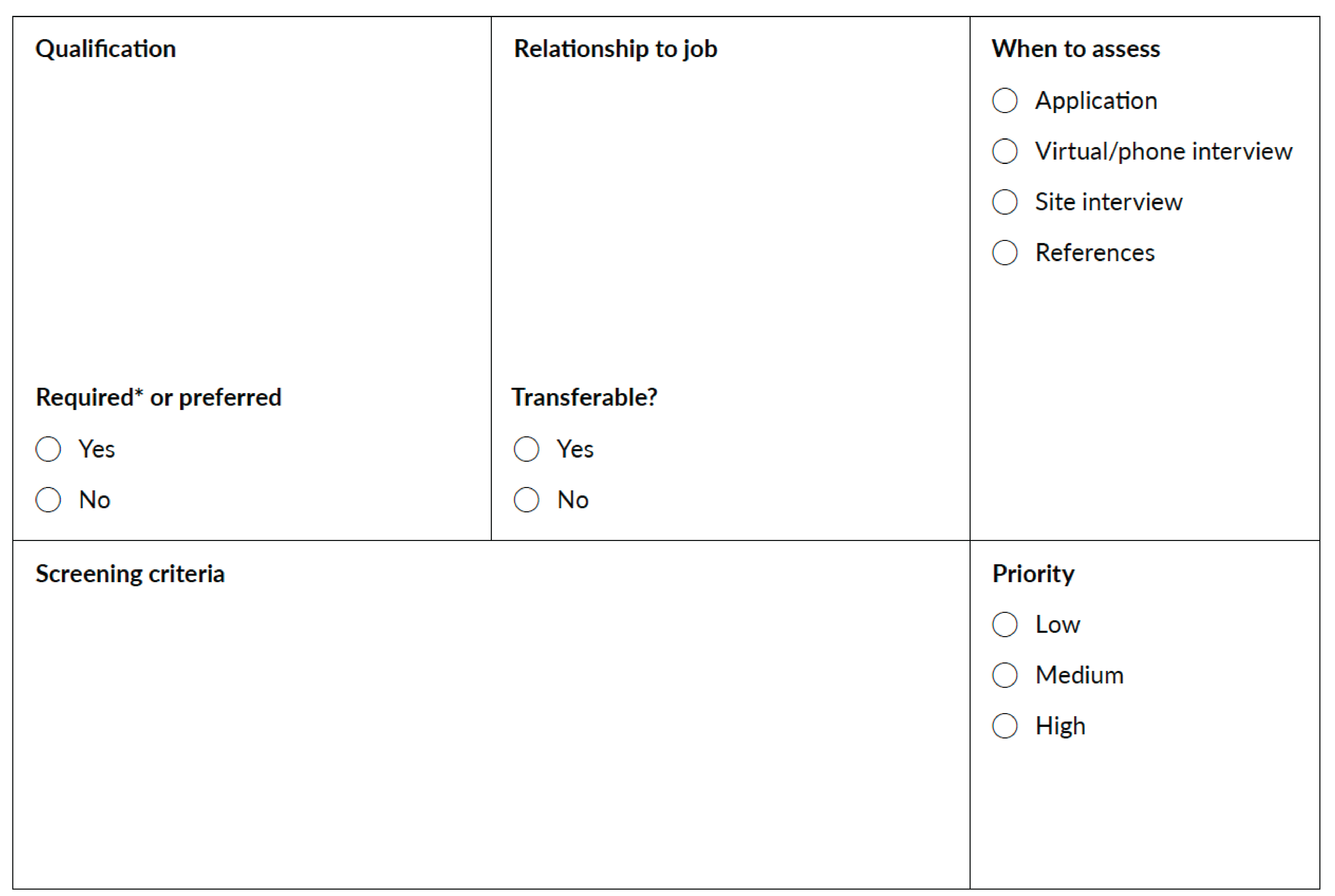
Screening matrix
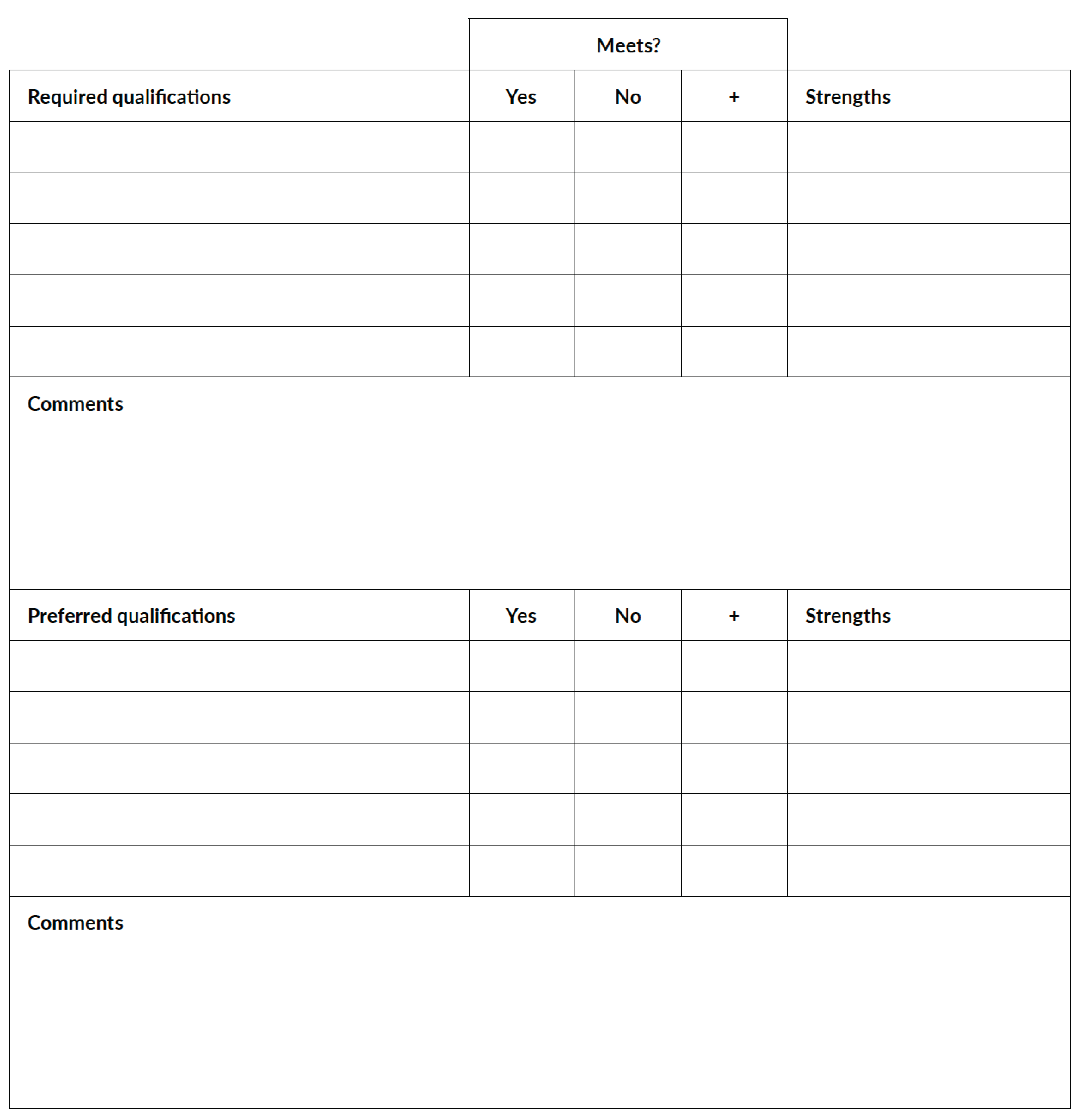
Sample criteria matrix
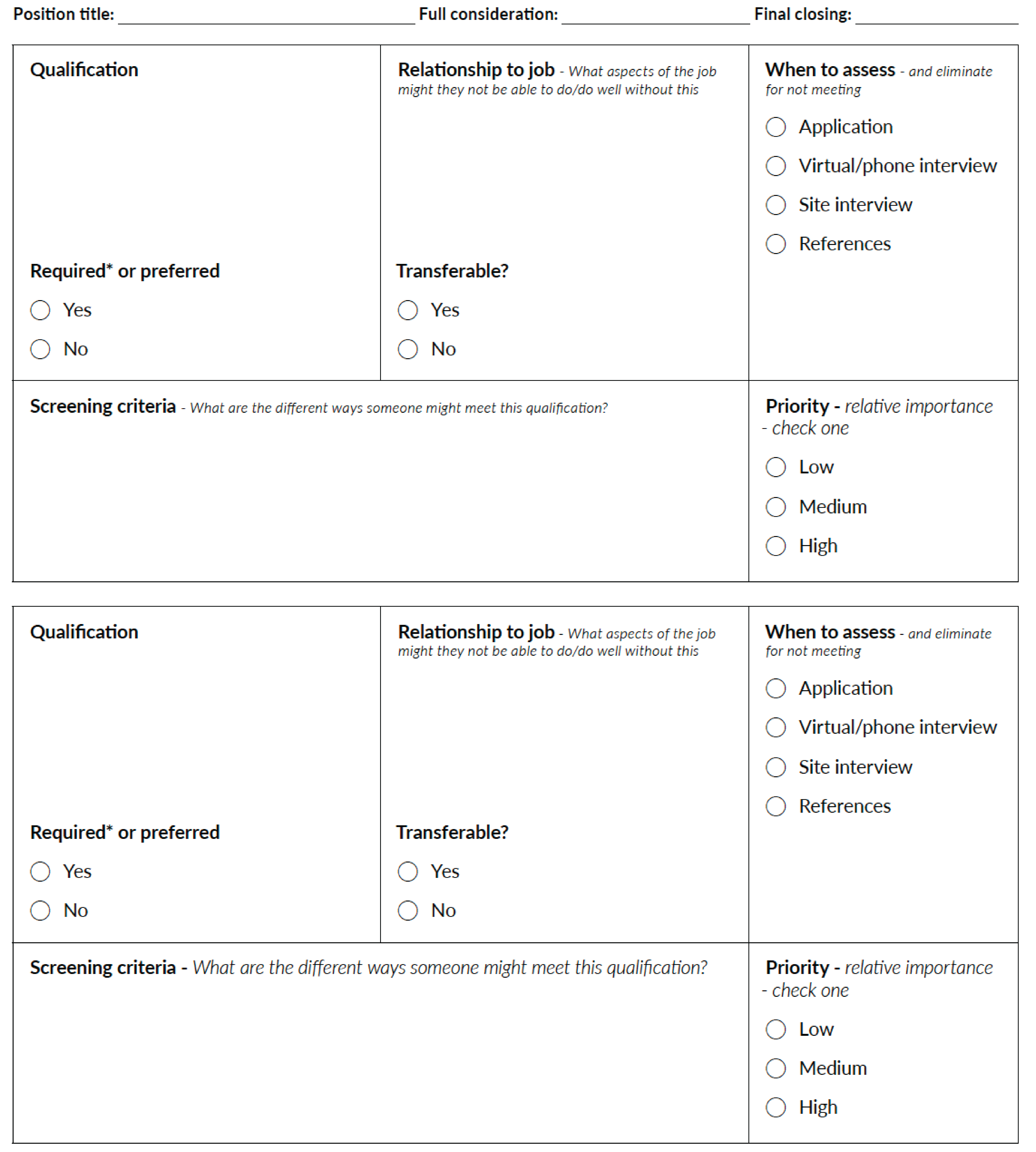
Sample screening matrix
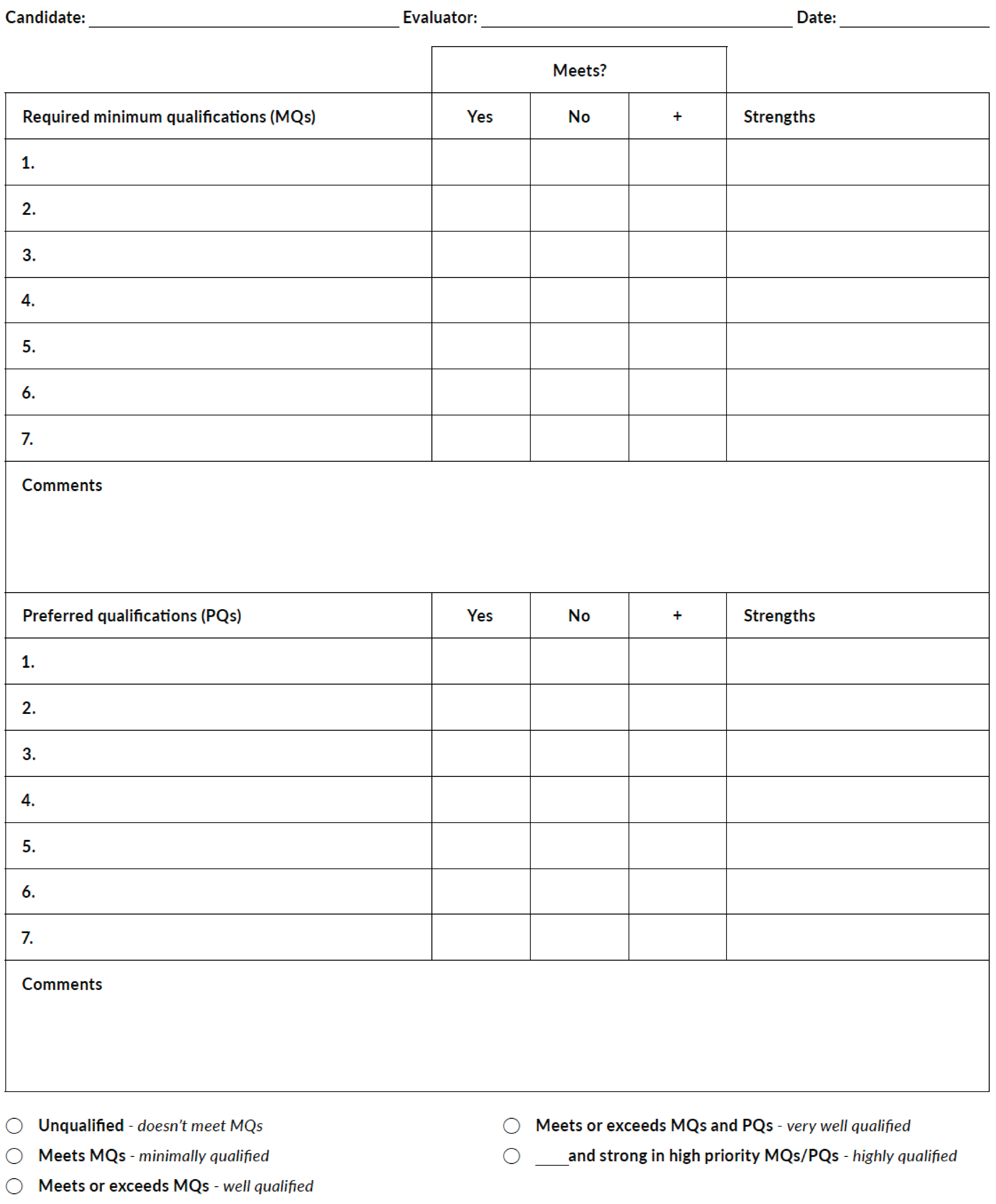
Sample multiple candidate screening summary
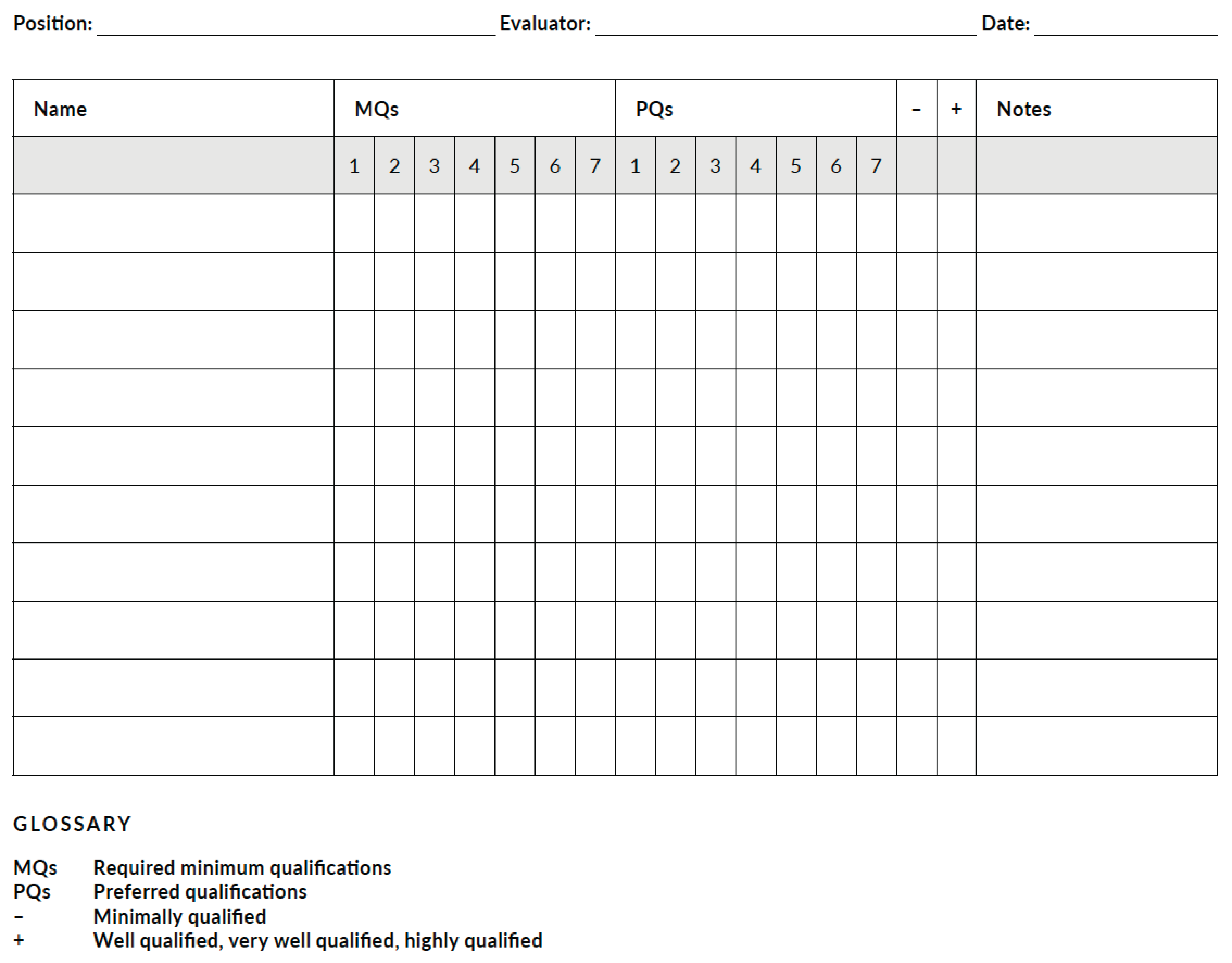
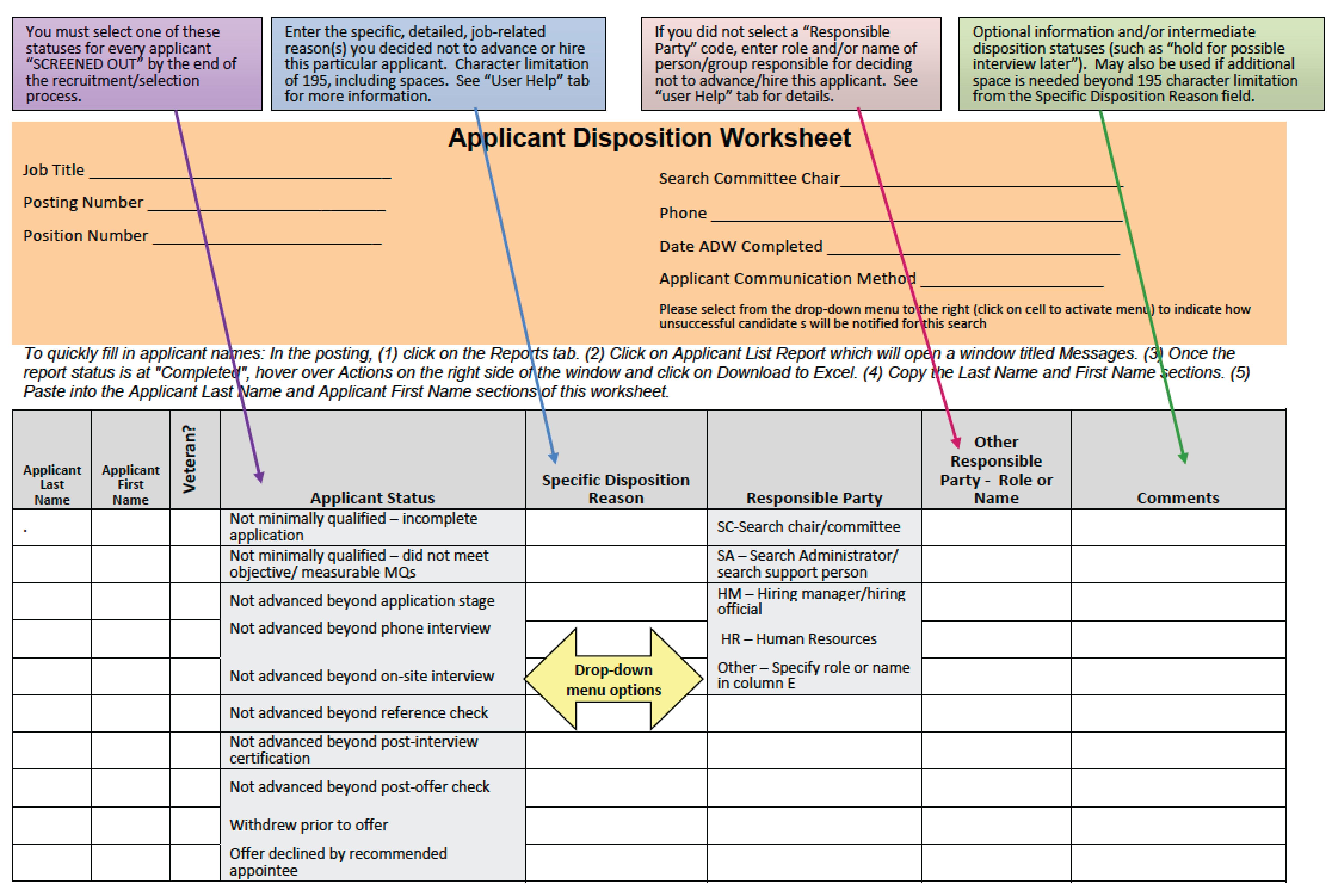
Example Interview questions from HERC Search Committee Toolkit (for senior position):
1. Search Chair or designate: Introductions, explain time constraints and format of interview
2. Before we get started, are there any questions we can answer for you? (Be prepared to answer potential questions about topics such as tuition and stipend for graduate students; cost of living for students; quality and pool of students).
3. How/who do you like to teach?
a. Overview of where you see your research in five years?
4. Researched-focused questions: Direct question to clarify item on CV or research plan
a. How many students have you graduated from your program/lab?
b. Status of grants or publications
5. Collaboration plans: Establish if candidate did homework on your university:
a. Tell us about some of your past collaborations across disciplines.
b. How did you find/establish those collaborations?
c. How do collaborations influence the future directions of your research?
d. Who do you see as a potential collaborator for you here?
e. If we brought you in for an interview, is there anyone outside of our department that you would like to meet?
6. If no past collaborations across disciplines:
a. How do you plan to initiate collaborations across disciplines?
b. Who do you see as a potential collaborators for you here?
7. Is the candidate moveable/serious?
a. Can you give the committee an idea of why you are looking to leave your university?
b. How intently have you been looking around? Are you on a timeline? (To establish if offers from other universities are pending)
c. What are your space requirements?
d. What are your equipment requirements?
8. Diversity, equity, and inclusion:
a. How have you demonstrated your commitment to ensuring diversity, equity and inclusion in recruitment/hiring/retention for all faculty members and/or students?
b. What do you think are the most important concerns of underrepresented [faculty members/ graduate students/undergraduates— could be race, gender, ethnicity etc.] in our field/discipline?
c. Tell us about a time that you successfully negotiated—or—describe a tough negotiation you participated in and what actions you took to resolve it.
d. Tell us about a time that you successfully managed an interpersonal problem between [students/faculty members/collaborators]—or—describe a tough interpersonal problem you experienced between [students/faculty members/collaborators] and what steps you took to resolve it.
e. What are your personal [attitudes, feelings, process, habits] when you are mentoring a junior faculty member—or—if we asked your mentees to describe your mentoring, what would they say?
f. What is one question we should be sure to ask your references about you?
9. Teaching-focused questions:
a. What classes/topic areas do you prefer to
Additional suggested questions
• What are the most important DEI issues in academia? How would you address as a provider/ researcher/administrator?
• If we were to ask your mentee to describe your mentorship style, what would they say?
• What is your preferred topic area do you prefer to teach or learn about?
• What new classes, curriculum, manuscript or
Appendix C | Local and National Organizations: Job Boards and Communities
Oregon Organizations
Urban League of Portland
ulpdx.org
Coalition of Communities of Color (CCC)
www.coalitioncommunitiescolor.org
CCC is an alliance of culturally-specific community
based organizations with representation from the
following communities of color: African, African
American, Asian, Latino, Middle Eastern and North
African, Native American, Pacific Islander, and Slavic.
Impact Oregon
impactoregon.careers
Impact Oregon connects job seekers with careers in the
field of developmental disabilities services in Oregon.
Partners in Diversity (PiD)
www.partnersindiversity.org
PiD works with employers to address critical needs for
achieving and empowering a workforce that reflects the
rapidly changing demographics of the Pacific Northwest
through educational programs, a career center and
resources for CEOs, human
National Organizations
Higher Education Recruitment Consortium (HERC)
hercjobs.org
A full list of vendor discounts is available at:hercjobs.org/member_resources/member_discounts
Ability Links
abilitylinks.org
AbilityLinks connects organizations that provide job placement, training and support services to job seekers
with disabilities and employers.
All Diversity: Inclusive Work Environments
alldiversity.com
National diversity job and employment job board - incorporates: outandequal.com; lgbtconnect.com; diversityinhighereducation.com; veteransconnect.com; disabilityconnect.com; diversityconnect.com; hispanicdiversity.com; womensjobcenter.com; blackjobcenter.com
Black Jobs
www.blackjobs.com
BlackJobs.com was created to promote well-paying job opportunities for African American job seekers to help reduce the high rate of unemployment in Black communities. Each post on the site includes a brief description of the positions available and a link where applicants can apply.
Campus Pride
www.campuspride.org
Resources, programs and services to support LGBTQ and ally students on college campuses - includes job board.
Career Contessa
careercontessa.com
Email list female-based job site sent to members
Diversity.com
diversity.com
Black-owned business focusing on job posts in the STEM fields.
Fairy Godboss
fairygodboss.com
Female driven job board posting
Female Executive Search
female-executive-search.com
Vetted candidate board for women executives
HBCU Connect
hbcuconnect.com
Platform for networking, professional opportunities, educational opportunities and connections with Historically Black Colleges and Universities
Higher Ed Jobs
www.higheredjobs.com
Course for jobs and career information in academia.
Hispanic Alliance for Career Enhancement
www.haceonline.org
HACE maintains a resume database of Latino professionals in a wide range of disciplines.
Hispanic/Latino Professionals Association
jobboard.hlpa.com
The HLPA continually publishes and updates career information and opportunities from quality socially
conscious organizations who support the Hispanic /Latino Community.
Hispanic Physicians IPA
HPIPA bring a wealth of benefit knowledge, patient care and physician relationship expertise to Hispanic Physicians, along with a dedication to delivering quality customer care.
In Roads
inroads.org
Develops and places minority students/graduates in business and industry to prepare for corporate and community leadership.
Minority Professional Network
www.minorityprofessionalnetwork.com
Broad spectrum of diversity, including racial, ethnic, cultural, gender, age, experience, functional, students, veterans, professionals, entrepreneurs and executives.
National Association of Asian American Professionals
www.naaap.org
The focus of NAAAP’s Career Center is to foster an online community that connects Asian and minority
professional talent with companies across the globe.
National Diversity Network
www.nationaldiversitynetwork.com
Network of niche job sites that highlight empoyers commited to recruiting and hiring diverse candidates, includes: africanamericanjobnetwork.com; asianjobnetwork.com; disabilityjobnetwork.com, latinojobnetwork.com; lgbtjobnetwork.com; retirementjobnetwork.com; veteranjobnetwork.com; womensjobnetwork.com
Native American Jobs
www.nativeamericanjobs.com
Nativeamericanjobs.com provides employment opportunities for all people from diverse, indigenous, and minority cultures
National Coalition of Black Meeting Professionals
ncbmp.com
The National Coalition of Black Meeting Professionals (NCBMP), founded in 1983, is a non-profit organization dedicated primarily to the training needs of African American meeting planners.
Pink Jobs
pink-jobs.com
LGBT, Gay Friendly Jobs and Candidates
Power To Fly
powertofly.com
Job board site dedicated to upskilling and connecting underrepresented talent to roles in highly visible sectors.
Professional Diversity Network
prodivnet.com
Network incorporating: military2career.com; womenscareerchannel.com; ihispano.com; blackcareernetwork.com; acareers.net (Asian Careers); outprofessionalnetwork.com; proable.net
Recruit Disability
recruitdisability.org
Employment initiative that makes information regarding job seekers with disabilities, and the programs that support them, available for use by hiring managers in virtually any industry across the country
Saludos
www.saludos.com
Specializes in joining the hispanic bilingual professional with companies looking for diversity in the workplace.
Society of Black Academic Surgeons (SBAS)
www.sbas.net
SBAS’ goal is to improve health, advance science, and foster careers of African American and other underrepresented minority surgeons
VetJobs
vetjobs.com
Employment opportunities for service members and veterans.
Work Force 50
workforce50.com
Job site focused on older and experienced audience.
